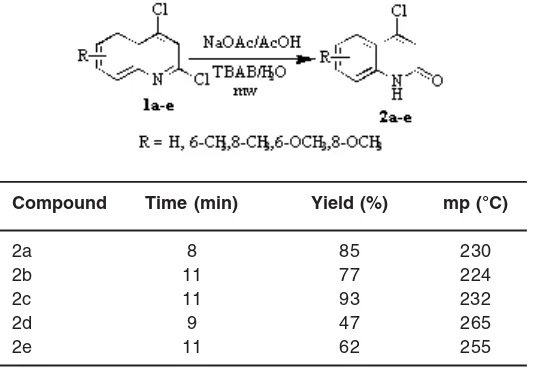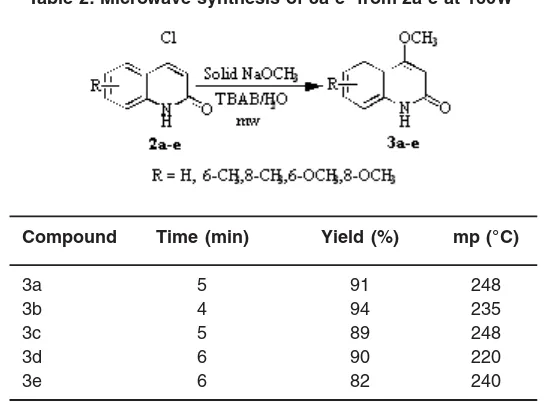INTRODUCTION
A considerable number of medicinally important quinoline alkaloids have been isolated from the Rutaceae family of plants1.Representative examples of some simple quinoline alkaloids include 4-methoxyquinolin-2(1H)-one and edulitine. These compound’s plant sources have been shown to exhibit a variety of biological properties including antibacterial2, antifungal3, antiviral4, anti-protozoal5 and anti-platelet aggregation6 activities. Also these compounds are found to be key intermediates in the synthesis of several furoquinoline and pyranoquinoline type heterocycles7. Recently, 4-methoxyquinolin-2(1H)-one was used for the synthesis of atanine8 and anticancerous indolo[2,3-b]quinoline derivatives).
Generally 4-methoxyquinolin-2(1H)-one is obtained from 2,4-dimethoxy quinoline by refluxing with hydrochloric acid or HBr, THF/H2O in 54%
Synthesis of some quinoline intermediates
under phase transfer catalyst
VETRIVEL NADARAJ¹* and SENNIAPPAN THAMARAI SELVI²
¹Department of Chemistry, Tamilnadu College of Engineering Karumathampatti Post, Coimbatore- 641 029 (India). ²Department of Chemistry University Garyounis, Benghazi (Libya).
(Received: April 22, 2009; Accepted: May 30, 2009)
ABSTRACT
The microwave synthesis of quinoline alkaloid 4-methoxyquinolin-2(1H)-one 3a and its analogues 3b-e was achieved in 8-11 minutes by methoxydechlorinated of 4-chloroquinolin-2(1H)-ones 2a-e using TBAB as phase transfer catalyst. The starting compound obtained by selective decholorination of 1a-e by sodium acetate/acetic acid and the structure of synthesized compound has been established by IR, 1H-NMR and Mass spectral data.
Key words: quinoline, alkaloids, acetic acid, phase tranfer cataylst, microwave.
yield7,8. In another report, 3a was prepared from 4-hydroxyquinolin-2(1H)-one by selective methylation using dimethyl sulphate, K2CO3 and acetone9. These processes suffer some disadvantages like longer reaction time, poor yield and use of hazardous chemicals.
In recent years, there is an increasing interest in the use of microwave-induced rate acceleration technology10, 11 in organic synthesis in view of the mild, clean, convenient, greater selectivity, easier workup, spontaneity of the reaction process in comparison to the conventional solution phase reactions and the associated ease of manipulation. It is of note that this technique offers an environmentally friendly process of organic synthesis12-14.
syntheses were achieved. Hence, by coupling microwave technology and solvent-free solid-liquid PTC conditions have become an efficient methodology to carry out organic reactions with substantial improvements in terms of reaction
conditions and simplicity in operating procedures. Herein we report a new and efficient solvent-free synthesis of 4-methoxyquinolin-2(1H)-ones from 4-chloroquinolin-2(1H)-ones and under PTC condition. (Scheme 1)
Scheme 1:
MATERIAL AND METHODS
Melting points were determined using Boetieus micro heating table and are uncorrected. IR (KBr, cm-1) spectra were obtained on Shimadzu– 8201 spectrometer. 1H-NMR and 13C-NMR spectra were recorded on Br uker AMX-400 MHz spectrometer using TMS as an internal reference (Chemical shifts in δ, ppm). Elemental analyses were performed on Perkin Elmer CHN-analyzer. Mass spectra were recorded on Shimadzu GCMS-QP5050A (70 ev) mass spectrometer. For microwave irradiation a Kenstar (OM-20ESP, 2450 MHz) domestic microwave oven was used.
General procedure for the synthesis of 4-chloroquinolin-2(1H)-ones (4a-e)
A mixture of 2,4-dichloroquinoline (1 mmol), sodium acetate (8 g) and acetic acid (10 mL) and tetrabutyl ammonium bromide (100 mg) was irradiated in a microwave oven at 160 W for the specified time (Table 1). After completion of the reaction, the mixture was poured into ice, the resulting white precipitate was filtered off and recrystalised from dilute acetic acid.
4-Chloroquinolin-2(1H)-one (2a)
IR (KBr, cm-1): 3200-3400, 1664. 1H NMR (DMSO), δH 11.20 (s, 1H, NH), 7.99 (d, 1H, C5-H), 7.59 (t, 1H, C7-H), 7.28-7.37 (m, 2H, C6-H & C8-H), 6.88 (s, 1H, C3-H). 13C NMR (DMSO), d
C 166.5, 147.2, 144.4, 130.5, 127.6, 124.8, 124,2, 123.3, 110.5. MS (70eV): m/z 179 (100 %, M+.), 181 (33%, M+.+2), 151, 144, 116.
6-Methyl-4-chloroquinolin-2(1H)-one (2b) IR (KBr, cm-1): 3150-3300, 1663. 1H NMR (DMSO), δH 11.18 (s, 1H, NH), 8.01 (s, 1H, C5-H), 7.30-7.66 (m, 2H, C7-H & C8-H), 6.86 (s, 1H, C3-H), 2.53 (s, 3H, C6-CH3. MS (70eV): m/z 193 (100 %, M+), 195 (33%, M+. +2).
8-Methyl-4-chloroquinolin-2(1H)-one (2c) IR (KBr, cm-1): 3200-3350, 1664. 1H NMR (DMSO), δH 11.21 (s, 1H, NH), 7.98 (d, 1H, C5-H), 7.32-7.62 (m, 2H, C6-H & C7-H), 6.87 (s, 1H, C3-H), 2.55 (s, 3H, C8-CH3. MS (70eV): m/z 193 (100 %, M+), 195 (33%, M+. +2).
6-Methoxy-4-chloroquinolin-2(1H)-one (2d) IR (KBr, cm-1): 3200-3400, 1664. 1H NMR (DMSO), δH 11.20 (s, 1H, NH), 7.97 (s, 1H, C5-H), 7.30-7.70 (m, 2H, C7-H & C8-H), 6.87 (s, 1H, C3-H), 3.90 (s, 3H, C6-OCH3. MS (70eV): m/z 209 (100 %, M+), 211 (33%, M+. +2).
8-Methoxy-4-chloroquinolin-2(1H)-one (2e) IR (KBr, cm-1): 3200-3400, 1663. 1H NMR (DMSO), δH 11.18 (s, 1H, NH), 7.99 (d, 1H, C5-H), 7.30-7.68 (m, 2H, C6-H & C7-H), 6.88 (s, 1H, C3-H), 3.91 (s, 3H, C8-OCH3. 13C NMR (DMSO), d
C 166.7, 149.8, 149.3, 145.2, 131.2, 125.2, 124.4, 123.8, 109.3, 55.6. MS (70eV): m/z 209 (100 %, M+), 211 (33%, M+. +2).
General procedure for the synthesis of 4-methoxyquinolin-2(1H)-ones (3a-e)
ammonium bromide (100 mg) and 0.5 mL of water was irradiated in a microwave oven for the specified time at 160 W (Table 2). After cooling to room temperature, the solid product formed was collected by filtration, dried and recrystalised from ethyl acetate.
4-Methoxyquinolin-2(1H)-one (3a)
IR (KBr, cm-1): 3100-3200, 1668. 1H NMR (DMSO), δH 11.34 (s, 1H, NH), 7.85 (d, J = 8.1 Hz, 1H, C5-H), 7.61 (t, 1H, C7-H), 7.37 (d, 1H, C8-H), 7.29 (t, 1H, C6-H), 5.87 (s, 1H, C3-H), 3.91 (s, 3H, C4-OCH3). 13C NMR (DMSO), d
C 166.4, 165.0, 138.7, 131.5, 123.1, 122.4, 115.1, 114.6, 96.2, 55.5. MS (70eV): m/z 175 (100 %, M+), 132 (63%, M+ -CONH).
6-Methyl-4-methoxyquinolin-2(1H)-one (3b) IR (KBr, cm-1) 3150-3310, 1664. 1H NMR (DMSO), δH 10.35 (s, 1H, NH), 7.90 (s, 1H, C5-H), 7.52 (d, 1H, C8-H), 7.32
(d, 1H, C7-H), 6.01 (s, 1H, C3-H), 3.93 (s, 3H, C4 -OCH3), 2.52 (s, 3H, C6-CH3). MS (70eV): m/z 189 (100 %, M+).
8-Methyl-4-methoxyquinolin-2(1H)-one (3c) IR (KBr, cm-1): 3200-3300, 1665. 1H NMR (DMSO), δH 10.46 (s, 1H, NH), 7.83 (d, J = 8.2 Hz, 1H, C5-H), 7.63 (d, 1H, C7-H), 7.31 (t, 1H, C6-H), 6.03 (s, 1H, C3-H), 3.92 (s, 3H, C4-OCH3), 2.49 (s,
3H, C8-CH3). MS (70eV): m/z 189 (100 %, M+).
6-Methoxy-4-methoxyquinolin-2(1H)-one (3d) IR (KBr, cm-1): 3200-3300, 1662. 1H NMR (DMSO), dH 10.72 (s, 1H, NH), 7.58 (s, 1H, C5-H), 7.52 (d, 1H, C8-H), 7.15 (d, 1H, C7-H), 5.88 (s, 1H, C3-H), 3.90 (s, 3H, C6-OCH3), 3.94 (s, 3H, C4-OCH3). MS (70eV): m/z 205 (100 %, M+).
8-Methoxy-4-methoxyquinolin-2(1H)-one (3e) IR (KBr, cm-1): 3210-3300, 1668. 1H NMR (DMSO), dH 10.35 (s, 1H, NH), 7.35 (d, J = 8.1 Hz, 1H, C5-H), 7.08-7.15 (m, 2H, C6-H & C7-H), 5.89 (s, 1H, C3-H), 3.90 (s, 3H, C4-OCH3), 3.87 (s, 3H, C8 -OCH3). 13C NMR (DMSO), d
C 166.5, 164.8, 149.8, 139.2, 132.3, 123.4, 115.2, 114.7, 96.5, 55.7, 54.3. MS (70eV): m/z 205 (100 %, M+).
RESULTS AND DISCUSSION
Our preliminary reaction centered on the dechlorination of 2,4-dichloroquinolines 1. When 1a was irradiated with acetic acid (20mL) for 20 min at 160 W under microwave, mixture of products was recovered. Elimination at C-2 position is known to be kinetically favored and the C-4 position is considerably slow process and increase the reaction time 2,4-dihydroxyquinoines obtained. Therefore, the same reaction was then tried out mixture sodium acetate/acetic acid and Phase Transfer Catalyst
Table 1: Microwave synthesis of 2a-e from 1a-e at 160W
Compound Time (min) Yield (%) mp (°C)
2a 8 85 230
2b 11 77 224
2c 11 93 232
2d 9 47 265
(PTC) such as tetrabutyl ammonium bromide (TBAB) and water under microwave condition. Gratifyingly, this reaction led to selective dechlorination of 1a and gave 4-chloro- quinolin-2(1H)-one. 2a as the exclusive product in 85% yield (mp. 230°C) (Table 1). The use of phase transfer catalyst reduced the reaction time from hours to min, and application of this methodology is further proved by the synthesis of derivatives of 4-chloroquinolin-2(1H)-one in very good yield (Fig 1; Table 1). IR spectrum of the product 2a showed absorptions at 1664 and 3250 cm-1 for 2-quinolinone moiety. The 1H-NMR spectrum registered two singlet at d 11.20 and d 6.88 for NH and CH protons, doublet at d 7.99 for C5-H and triplet at d 7.59 for C7-H and also registered unresolved multiplet at d
Table 2: Microwave synthesis of 3a-e from 2a-e at 160W
Compound Time (min) Yield (%) mp (°C)
3a 5 91 248
3b 4 94 235
3c 5 89 248
3d 6 90 220
3e 6 82 240
7.28-7.37 for C6 and C8 protons. The mass spectrum showed a molecular ion peak at m/z 179 (100 %, M+.) and other peaks at, 181 (33%, M+.+2), 151, 144, 116. 1H-NMR and mass spectra also proved 2a as 4-chloroquinolin-2(1H)-one. Fur ther, methoxydecholorination of 2a with solid sodium methoxide in presence of TBAB under microwave irradiation for 4 min gave 4-methoxyquinolin-2(1H)-one (3a) in 92% yield. (Fig 2; Table 2). All the yields were calculated from crystallized products and the products were identified by comparison of analytical data (mp, mmp, IR, NMR, Mass) with those reported or with authentic samples prepared by the conventional methods. Some new derivatives were also prepared and reported.
Graphical Abstract
CONCLUSIONS
In conclusion, the PTC catalysed selective decholrination reaction of 2,4-dichloroquinolines entails an efficient, very easy and solventless method for the synthesis of 4-chloroquinolin-2(1H)-one, followed by methoxylation gave natural quinoline alkaloids like 4-methoxyquinolin-2(1H)-one, edulitine, and their synthetic analogs in good yields and very short reaction time. We believe this will provide a better and more practical alternative
to the existing methodologies for the synthesis of the above alkaloids.
ACKNOWLEDGMENTS
The author VN is grateful to Director of Collegiate Education, Government of Tamilnadu, India, for financial suppor t. Authors thank NMR Research centre, Indian Institute of Science, Bangalore, India for providing NMR spectral data.
1. Michael J. P., Nat. Prod. Rep., 17: 603 (2000). 2. Towers G.H.N., Graham E.A., Spenser I.D. and Abramowski Z., Planta Med., 41: 136 (1981).
3. Biavatti M.W., Vieira P.C., DeSilva M.F.D.F., Fernandes J.B., Victor S.R., Pagnocca F.C., Albuquerque S., Caracelli I. and Zukerman-Schpector J., J. Braz. Chem. Soc., 13: 66 (2002).
4. McCormick J.L., McTee T.C., Cardellina J.H. and Boyd M.R., J. Nat. Prod., 59: 469 (1996). 5. Four net A., Barr ios A.A., Munioz V., Hocquemiller R., Cave A. and Bruneton J., J. Antimicrob. Agents Chemother., 37: 859 (1993).
6. Chen I.-S., Tsai I.-W., Teng C.-M., Chen J.-J., Chang Y.-L. Ko F.-N., Lu M.C. and Pezzuto J.M., Phytochemistry, 46: 525 (1997). 7. Narasimhan N.S., Paradkar, M.V. and Alurkar
R.H.,Tetrahedron, 27: 1351 (1971). 8. Jones K., Roset X., Rossiter S. and Whitfield
P., Org. Biomol. Chem., 1: 4380 (2003). 9. Chen Y.-L., Hung H.-M., Lu C.-M., Li K.-C.
and Tzeng C.-C., Bioorg. Med. Chem., 12: 6539 (2004).
10. Caddick S., Tetrahedron, 51: 10403 (1996). 11. Tu S., Zhange Y., Jia R., Jiang, B. Zhang J. and Ji S., Tetrahedron Lett., 47: 6521 (2007). 12. Thamarai Selvi S., Nadaraj V., Mohan S., Sasi R. and Hema M., Bioorg. Med. Chem., 14: 3896 (2006).
13. Nadaraj V., Thamarai Selvi S. and Sasi R., Arkivoc, 82 (2006).
14. Nadaraj V., Thamarai Selvi S. and Mohan S., Eur. J. Med. Chem., 44, 976 (2009). 15. Rao G.V. P., Narasimha Reddy P., Thirupathi
Reddy Y., Naveen Kumar V. and Rajitha B., Indian J. Chem., 44B: 1109 (2005). 16. Louby A. and Luche J.L. Hand Book of Phase

